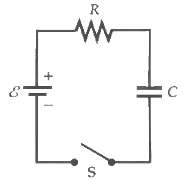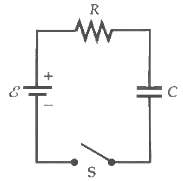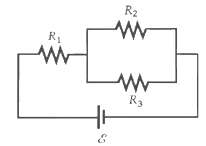(Multiple choice) (1) Kirchoff's loop rule follows from (a) Conservation of charge. (b) Conservation of energy. (c)...
Question:
(Multiple choice)
(1)
Kirchoff's loop rule follows from
(a) Conservation of charge.
(b) Conservation of energy.
(c) Newton's laws.
(d) Coulomb's law.
(e) Quantization of charge.
(2)
The capacitor C in Figure is initially uncharged. Just after the switch S is closed,
(a) The voltage across C equals.
(b) The voltage across R equals.
(c) The current in the circuit is zero.
(d) Both (a) and (c) are correct.

(3)
During the time it takes to fully charge the capacitor of Figure,?
(a) The energy supplied by the battery is ? CE2
(b) The energy dissipated in the resistor is ? CE2
(c) Energy is dissipate d in the resistor at a constant rate.?
(d) The total charge flowing through the resistor is ? CE2

(4)
A battery is connected to a series combination of a switch, a resistor, and an initially uncharged capacitor. The switch is closed at t = 0. Which of the following statements is true?
(a) As the charge on the capacitor increases, the current increases.
(b) As the charge on the capacitor increases, the voltage drop across the resistor increases.
(c) As the charge on the capacitor increases, the current remains constant.
(d) As the charge on the capacitor increases, the voltage drop across the capacitor decreases.
(e) As the charge on the capacitor increases, the voltage drop across the resistor decreases.
(5) True or false:
(a) Ohm's law is R = V/I.?
(b) Electrons drift in the direction of the current.?
(c) A source of emf supplies power to an electrical circuit.?
(d) When the potential drops by V in a segment of circuit, the power supplied to that segment is IV.?
(e) The equivalent resistance of two resistors in parallel is always less than the resistance of either resistor alone.?
(f) The terminal voltage of a battery always equals its emf.?
(g) The terminal voltage of a battery is always less than its emf.
(6)
In Figure, all three resistors are identical. The power dissipated is?
(a) The same in R1 as in the parallel combination of R2 andR3.?
(b) The sameinR1 andR2.?
(c) Greatest in R1.?
(d) Smallest in R1.

(7)
In Figure, R1?= 4?, R2 = 6?, and R3?= 12 ?. If we denote the currents through these resistors by I1, I2, and I3, respectively, then?
(a) I1?> I2?> I3.
(b) I2?= I3.?
(c) I3?> I2.?
(d) None of the above is correct.

(8)
If the battery emf in Figure is 24 V, then?
(a) I2 = 4A.?
(b) I2 = 2A.?
(c) I2?= 1A.?
(d) None of the above is correct.

Step by Step Answer:

Fundamentals of Ethics for Scientists and Engineers
ISBN: 978-0195134889
1st Edition
Authors: Edmund G. Seebauer, Robert L. Barry





